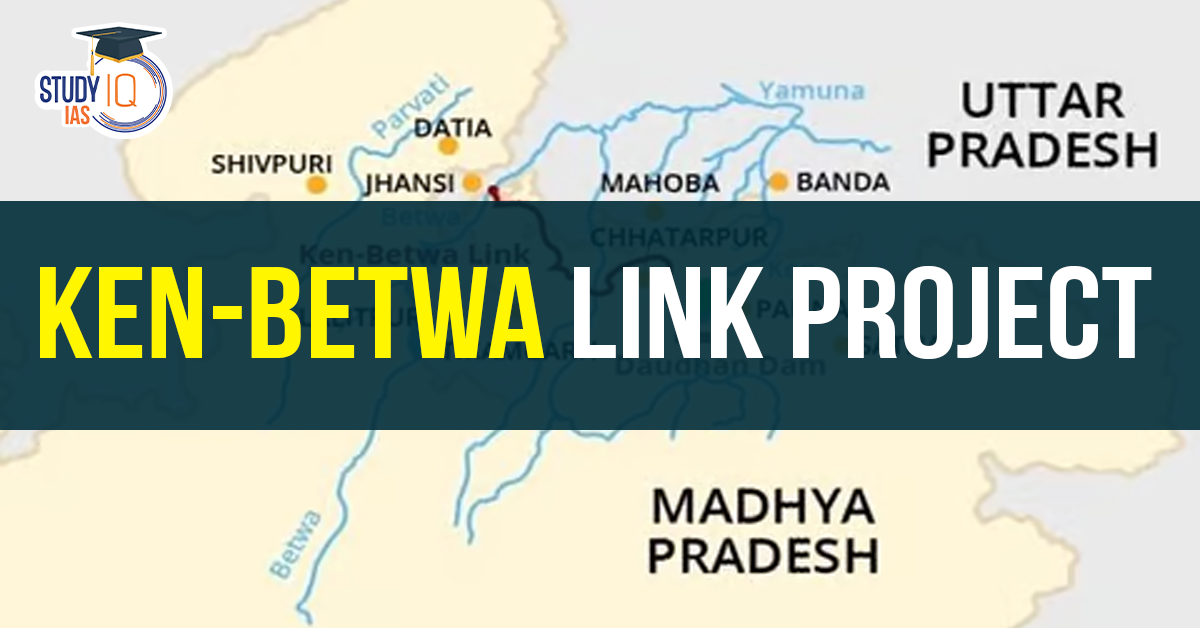Table of Contents
Context: PM Narendra Modi has laid the foundation stone for the Ken-Betwa river-linking project on the 100th birth anniversary of former Prime Minister Atal Bihari Vajpayee.
About Ken-Betwa Link Project (KBLP)
- Aim: To transfer excess water from the Ken River to the Betwa River to solve the water woes of the Bundelkhand region. It’s the first interlinking project under the National Perspective Plan (1980).
Components
- Ken-Betwa Link Canal: 221 km in length (including a 2 km tunnel) for water diversion.
- Phase-I: Construction of Daudhan Dam, related tunnels, canal, and powerhouses.
- Phase-II: Building of Lower Orr Dam, Bina Complex Project and Kotha Barrage.

Benefits of the Project
- Irrigation: 10.62 lakh hectares (8.11 lakh ha in Madhya Pradesh; 2.51 lakh ha in Uttar Pradesh).
- Drinking Water: 62 lakh people.
- Power Generation: 103 MW hydropower, 27 MW solar power.
| Facts |
|
What are the Various Concerns Related to the Project?
Environmental Impact
The construction of the dam within the Panna Tiger Reserve will submerge a significant area, threatening biodiversity, wildlife habitats, and tiger conservation efforts.
- Eco-services of rivers, such as silt deposition for delta formation and maintaining ecological balance, will be disrupted.
- Eg., A study by IIT-Bombay scientists found that moving large quantities of water as part of river-linking projects can affect land-atmosphere interplay and feedback, leading to a mean rainfall deficit of up to 12% in September.
Hydrological Imbalance
Claims of “surplus” water in the Ken River ignore its role in maintaining downstream ecosystems, including deltaic regions. Climate change and altered rainfall patterns may reduce water availability, jeopardizing the project’s viability.
Socioeconomic Costs
The estimated cost of ₹45,000 crore (part of ₹5.5 lakh crore for all interlinking projects) does not factor in social displacement, loss of livelihoods, and long-term operational expenses. Taxes will likely burden common citizens to fund the project.
Historical Lessons
Examples such as the degradation of the Indus Delta and the Narmada downstream areas highlight the risks of river manipulation. International disasters, such as the Aral Sea’s desertification and the Kissimmee River’s channelisation in Florida, reinforce the environmental consequences of large-scale geoengineering projects.
Policy and Governance Gaps
Circumvention of legal provisions and expert recommendations ( including members of an empowered committee appointed by the Supreme Court of India) undermines environmental regulations. The lack of comprehensive studies on the project’s feasibility and impact raises concerns about decision-making processes.
Cultural and Ideological Contradictions
The project contradicts the cultural ethos of reverence for rivers, emphasized by the ruling regime’s Hindutva ideology, by prioritizing commodification and exploitation over preservation.
Way Forward
Holistic Watershed Management
Implement a national water policy focusing on watershed management and involving local stakeholders. Promote aquifer management and regulate groundwater usage through scientific monitoring.
Adoption of Sustainable Agricultural Practices
Introduce modern irrigation techniques like Israel’s drip irrigation to reduce water usage and maintain aquifer health. Train farmers in efficient irrigation practices to optimize water use and minimize wastage.
Revival of Vernacular Practices
Integrate traditional water management practices, such as rainwater harvesting and tank systems, into modern frameworks. Leverage community knowledge for localized solutions to water management challenges.
Improved Wastewater Management
Establish innovative wastewater reuse programs to reduce dependence on river water for industrial and agricultural purposes. Enhance urban water management systems to conserve resources.
Preserving Ecosystem Services
Avoid projects that compromise the ecological balance of rivers, including their role in groundwater recharge, delta formation, and biodiversity sustenance. Strengthen legal protections for river ecosystems and enforce compliance with environmental laws.
Climate Change Adaptation
Incorporate climate-resilient strategies to manage water resources, considering variability in rainfall and river flows. Develop alternatives to inter-basin transfers, such as local water conservation and decentralized management.


 National Technology Readiness Assessment...
National Technology Readiness Assessment...
 Justice Mission-2025: China’s Live-Fir...
Justice Mission-2025: China’s Live-Fir...
 Suryastra: First Made-in-India Long-Rang...
Suryastra: First Made-in-India Long-Rang...

























